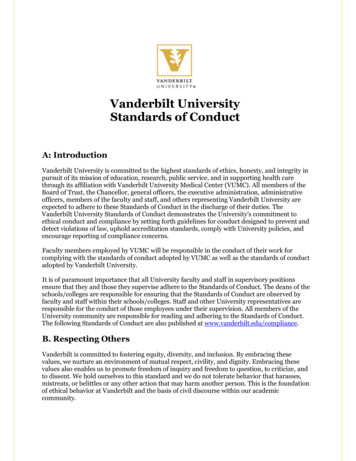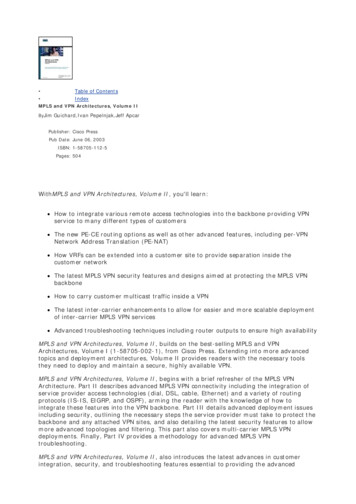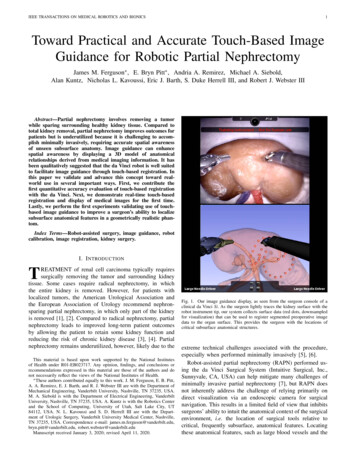
Transcription
Overview of Layered ArchitecturesDouglas C. edu/ schmidtProfessor of Computer ScienceInstitute for SoftwareIntegrated SystemsVanderbilt UniversityNashville, Tennessee, USA
Learning Objectives in this Lesson1. Know what layeredarchitectures areApplication LayerApplicationsPresentation LayerDomain-SpecificMiddleware ServicesSession LayerCommonMiddleware ServicesTransport LayerDistributionMiddlewareInternetLayerHost InfrastructureMiddlewareData Link LayerOperating Systems& ProtocolsPhysical LayerHardware2
Learning Objectives in this Lesson1. Know what layeredarchitectures are2. Understand the Layersarchitectural patternLayer interfaceLayer CLayerimplementationLayer BLayer A3
Learning Objectives in this Lesson1. Know what layeredarchitectures are2. Understand the Layersarchitectural pattern3. Recognize the layers inAndroid’s software stackART Dalvik Virtual Machine4
Learning Objectives in this Lesson1. Know what layeredarchitectures are2. Understand the Layersarchitectural pattern3. Recognize the layers inAndroid’s software stack4. Realize why layeringis used in AndroidART Dalvik Virtual Machine5
Overview ofLayered Architectures6
An Overview of Layered Architectures Layering is applied in many domains7
An Overview of Layered Architectures Layering is applied in many domains, e.g. Computer networking protocol stacksApplication ables end-to-end communicationby specifying how data should be(un)packetized, addressed,transmitted, routed, & receivedInternetLayerData LinkLayerPhysical LayerSee en.wikipedia.org/wiki/Protocol stack8
An Overview of Layered Architectures Layering is applied in many domains, e.g. Computer networking protocol stacks Lower layers handle interactionswith the hardware e.g., GSM, DSL, & EthernetApplication ternetLayerData LinkLayerPhysical LayerSee en.wikipedia.org/wiki/Link layer 9& en.wikipedia.org/wiki/Physical layer
An Overview of Layered Architectures Layering is applied in many domains, e.g. Computer networking protocol stacks Lower layers handle interactionswith the hardware Middle layers exchange packetsacross hosts & routers e.g., IP, TCP, & UDPApplication ternetLayerData LinkLayerPhysical LayerSee en.wikipedia.org/wiki/Internet layer10& en.wikipedia.org/wiki/Transport layer
An Overview of Layered Architectures Layering is applied in many domains, e.g. Computer networking protocol stacks Lower layers handle interactionswith the hardware Middle layers exchange packetsacross hosts & routers Upper layers implement & interactwith applications e.g., PPTP, XDR, CDR, JSONApplication ternetLayerData LinkLayerPhysical LayerSee en.wikipedia.org/wiki/Session layer 11& en.wikipedia.org/wiki/Presentation layer
An Overview of Layered Architectures Layering is applied in many domains, e.g. Computer networking protocol stacks Lower layers handle interactionswith the hardware Middle layers exchange packetsacross hosts & routersApplication LayerPresentationLayerSessionLayer Upper layers implement & interactTransportLayer Applications (& middleware) mostlyInternetLayerwith applicationsjust deal with the upper layer(s) e.g., FTP, TELNET, SMTP, & SNMPData LinkLayerPhysical LayerSee en.wikipedia.org/wiki/Application layer12
An Overview of Layered Architectures Layering is applied in many domains, e.g. Computer networking protocol stacks Communication middleware inmulti-tier enterprise IT systemsApplicationsDomain-SpecificMiddleware ServicesCommonMiddleware ServicesDistributionMiddlewareProvides services beyond the operatingsystem & protocol stacks to enablecomponents in a distributed system tocommunicate & manage dataHost InfrastructureMiddlewareOperating Systems& ProtocolsHardwareSee en.wikipedia.org/wiki/Middleware (distributed applications)13
An Overview of Layered Architectures Layering is applied in many domains, e.g. Computer networking protocol stacks Communication middleware inmulti-tier enterprise IT systems Lower layers provide portableAPIs for accessing hardware& system resources e.g., Linux, Windows, JVM, & ACEApplicationsDomain-SpecificMiddleware ServicesCommonMiddleware ServicesDistributionMiddlewareHost InfrastructureMiddlewareOperating Systems& ProtocolsHardwareSee www.dre.vanderbilt.edu/ schmidt/PDF/middleware-encyclopedia.pdf14
An Overview of Layered Architectures Layering is applied in many domains, e.g. Computer networking protocol stacks Communication middleware inmulti-tier enterprise IT systems Lower layers provide portableAPIs for accessing hardware& system resources Middle layers shield applicationsfrom network programming details e.g., DDS, Web Services, MQTT,Spring, CORBA, etc.ApplicationsDomain-SpecificMiddleware ServicesCommonMiddleware ServicesDistributionMiddlewareHost InfrastructureMiddlewareOperating Systems& ProtocolsHardwareSee www.dre.vanderbilt.edu/ schmidt/PDF/middleware-encyclopedia.pdf15
An Overview of Layered Architectures Layering is applied in many domains, e.g. Computer networking protocol stacks Communication middleware inmulti-tier enterprise IT systems Lower layers provide portableAPIs for accessing hardware& system resourcesApplicationsDomain-SpecificMiddleware ServicesCommonMiddleware ServicesDistributionMiddleware Middle layers shield applicationsHost InfrastructureMiddleware Upper layers enable domain-specificOperating Systems& Protocolsfrom network programming detailsreuse of capabilities e.g., MD-PnP, IIC, & FACEHardwareSee www.dre.vanderbilt.edu/ schmidt/PDF/middleware-encyclopedia.pdf16
An Overview of Layered Architectures Layering is applied in many domains, e.g. Computer networking protocol stacks Communication middleware inmulti-tier enterprise IT systems Lower layers provide portableAPIs for accessing hardware& system resourcesApplicationsDomain-SpecificMiddleware ServicesCommonMiddleware ServicesDistributionMiddleware Middle layers shield applicationsHost InfrastructureMiddleware Upper layers enable domain-specificOperating Systems& Protocolsfrom network programming detailsreuse of capabilities Applications may deal w/multiple layersHardwareSee www.dre.vanderbilt.edu/ schmidt/PDF/middleware-encyclopedia.pdf17
Overview of the LayersArchitectural Pattern18
An Overview of the Layers Architectural Pattern The concept of layering has beenexpressed as an architectural pattern19See www.dre.vanderbilt.edu/ schmidt/POSA
An Overview of the Layers Architectural Pattern The concept of layering has beenexpressed as an architectural pattern“a structural organization schema forsoftware systems that provides a set of predefinedsubsystems specifies their responsibilities & includes rules & guidelines fororganizing the relationshipsbetween these roles”20See en.wikipedia.org/wiki/Architectural pattern
An Overview of the Layers Architectural Pattern The concept of layering has beenexpressed as an architectural pattern“a structural organization schema forsoftware systems that provides a set of predefinedsubsystems specifies their responsibilities & includes rules & guidelines fororganizing the relationshipsbetween these roles”21See en.wikipedia.org/wiki/Architectural pattern
An Overview of the Layers Architectural Pattern The concept of layering has beenexpressed as an architectural pattern“a structural organization schema forsoftware systems that provides a set of predefinedsubsystems specifies their responsibilities & includes rules & guidelines fororganizing the relationshipsbetween these roles”22See en.wikipedia.org/wiki/Architectural pattern
An Overview of the Layers Architectural Pattern The concept of layering has beenexpressed as an architectural pattern“a structural organization schema forsoftware systems that provides a set of predefinedsubsystems specifies their responsibilities & includes rules & guidelines fororganizing the relationshipsbetween these roles”23See en.wikipedia.org/wiki/Architectural pattern
An Overview of the Layers Architectural Pattern The Layers architectural pattern hasbeen described in various publications24See en.wikipedia.org/wiki/Multilayered architecture
An Overview of the Layers Architectural Pattern The Layers pattern structures software apps & infrastructure in several waysLayer CLayer interfaceLayerimplementationLayer BLayer A25See ttern.html
An Overview of the Layers Architectural Pattern The Layers pattern structures software apps & infrastructure in several waysa. Partitions an overall system architecture into groups of subtasksLayer interfaceLayer CLayerimplementationLayer BLayer A26
An Overview of the Layers Architectural Pattern The Layers pattern structures software apps & infrastructure in several waysa. Partitions an overall system architecture into groups of subtasksb. Decomposes groups of subtasks into levels of abstractionLayer interfaceLayer CLayerimplementationLayer BLayer A27
An Overview of the Layers Architectural Pattern The Layers pattern helps to simplify software development & evolution28
An Overview of the Layers Architectural Pattern The Layers pattern helps to simplify software development & evolution e.g., it replaces tightly coupled “big balls of mud” Function 1Function 2Function BFunction 3Function YFunction XFunction AFunction CFunction ZSee en.wikipedia.org/wiki/Big ball of mud29
An Overview of the Layers Architectural Pattern The Layers pattern helps to simplify software development & evolution e.g., it replaces tightly coupled “big balls of mud” with modular solutionsthat can be extended & contracted more easilyLayer interfaceLayer CLayerimplementationLayer BLayer ASee www.dre.vanderbilt.edu/ schmidt/family.pdf30
An Overview of the Layers Architectural Pattern Be careful when implementing a layered architecture to avoid unnecessaryoverhead when exchanging data between the layersLayer CLayer interfaceLayerimplementationLayer BLayer ASee www.dre.vanderbilt.edu/ schmidt/PDF/p96-van renesse.pdf31
An Overview of the Layers Architectural Pattern Be careful when implementing a layered architecture to avoid unnecessaryoverhead when exchanging data between the layers e.g., minimize context switching, synchronization, & data copying overheadLayer interfaceLayer CLayerimplementationLayer BLayer ASee www.cs.wustl.edu/ schmidt/PDF/dissertation.pdf32
An Overview ofAndroid’s LayeredArchitecture33
An Overview of Android’s Layered Architecture Android’s architecture isstructured in accordanceto multiple layersART Dalvik Virtual Machine34
An Overview of Android’s Layered Architecture Android’s architecture isstructured in accordanceto multiple layersART Dalvik Virtual Machine35The Android Linux kernel controls hardware& manages system resources
An Overview of Android’s Layered Architecture Android’s architecture isstructured in accordanceto multiple layersART Dalvik Virtual MachineSeveral layers of middleware provide36higher-level reusable services to apps
An Overview of Android’s Layered Architecture Android’s architecture isstructured in accordanceto multiple layersART Dalvik Virtual Machine37The application layer provides packagedfunctionality to end-users
An Overview of Android’s Layered Architecture Layering is applied in complex systems like Android for several ariesVM &RuntimeHardware AbstractionLayerOperating SystemKernelHardware38
An Overview of Android’s Layered Architecture Layering is applied in complex systems like Android for several reasons, e.g. Enhance systematic software iesVM &RuntimeHardware AbstractionLayerAn intentional strategy for increasingproductivity & improving software qualityOperating SystemKernelHardware39See en.wikipedia.org/wiki/Code reuse#Systematic software reuse
An Overview of Android’s Layered Architecture Layering is applied in complex systems like Android for several reasons, e.g. Enhance systematic software iesVM &RuntimeHardware AbstractionLayerOperating SystemKernellibC provides a common API foraccessing OS kernel capabilitiesHardware40
An Overview of Android’s Layered Architecture Layering is applied in complex systems like Android for several reasons, e.g. Enhance systematic software iesVM &RuntimeHardware AbstractionLayerEnable apps to run concurrently overvarious types of multi-core hardware41Operating SystemKernelHardware
An Overview of Android’s Layered Architecture Layering is applied in complex systems like Android for several reasons, e.g. Enhance systematic software reuseApplications Enable “plug & play” replacement ofApplicationFrameworkscertain layer implementationsNativeLibrariesVM &RuntimeHardware AbstractionLayerOperating SystemKernelHardware42
An Overview of Android’s Layered Architecture Layering is applied in complex systems like Android for several reasons, e.g. Enhance systematic software reuseApplications Enable “plug & play” replacement ofApplicationFrameworkscertain layer implementationsNativeLibrariesShield apps frominconsistenthardware APIsVM &RuntimeHardware AbstractionLayerOperating SystemKernelHardware43
An Overview of Android’s Layered Architecture Layering is applied in complex systems like Android for several reasons, e.g. Enhance systematic software reuseApplications Enable “plug & play” replacement ofcertain layer sVM &RuntimeHardware AbstractionLayerOperating SystemKernelHardware44 layer whose implementation changesEffects of updates can be confined to the
An Overview of Android’s Layered Architecture Layering is applied in complex systems like Android for several reasons, e.g. Enhance systematic software reuseApplications Enable “plug & play” replacement ofcertain layer implementations Reduce the complexity of APIs thatapp developers must understandApplicationFrameworksNativeLibrariesVM &RuntimeHardware AbstractionLayerOperating SystemKernelHardwareSee en.wikipedia.org/wiki/Facade pattern45
An Overview of Android’s Layered Architecture Layering is applied in complex systems like Android for several reasons, e.g. Enhance systematic software reuseApplications Enable “plug & play” replacement ofcertain layer implementations Reduce the complexity of APIs thatapp developers must understand Enable use of popular protocols, APIs,& programming languagesApplicationFrameworksNativeLibrariesVM &RuntimeHardware AbstractionLayerOperating SystemKernelHardware46
An Overview of Android’s Layered Architecture Layering is applied in complex systems like Android for several reasons, e.g. Enhance systematic software reuseApplications Enable “plug & play” replacement ofcertain layer implementations Reduce the complexity of APIs thatapp developers must understand Enable use of popular protocols, APIs,& programming languages These popular protocols & APIsare available in open-source formApplicationFrameworksNativeLibrariesVM &RuntimeHardware AbstractionLayerOperating SystemKernelHardwareSee source.android.com & source.android.com/source/building-kernels.html47
End of Overview ofLayered Architectures48
11 Layering is applied in many domains, e.g. Computer networking protocol stacks Lower layers handle interactions with the hardware Middle layers exchange packets across hosts & routers Upper layers implement & interact with applications e.g., PPTP, XDR, CDR, JSON An Overview of Layered Architectures Physical Layer Presentation Layer










